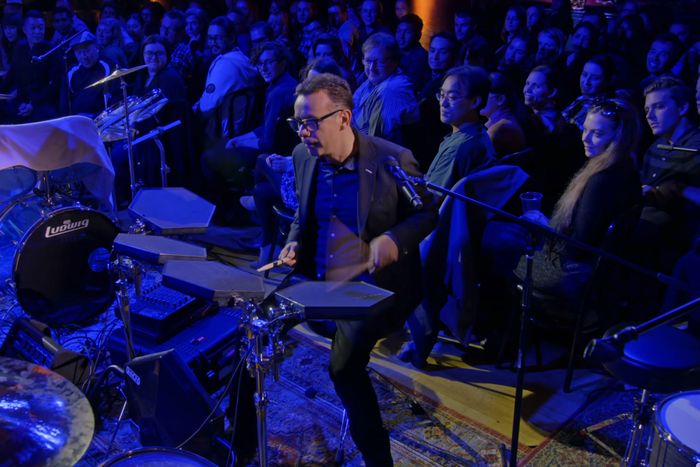
“I love inside jokes. I’d love to be a part of one someday.” So said Michael Scott in a season-three episode of The Office, in GIFs all over the internet, and in quotes on Hinge profiles far and wide. Anyone who has lived out this fantasy knows that jokes are interpreted differently by different audiences. For stand-up comedians, the goal is often to avoid this — to ensure their material is accessible to anyone out of context.
Over the last two decades, a handful of comedians have begun to tinker with this expectation by releasing experimental specials taped in front of extremely specific audience demographics: incarcerated people, 15-year-old boys, the comedian’s own parents, and more. In instances where these specials are inaccessible to at-home audiences, it’s by design. These viewers know who the intended audience for this material is, and they view it through that lens. Whatever the explicit text of these specials, the subtext is the fascinating interplay between the performer and subset of people who comprise their live audience. As recently as May, comedians Colin Quinn and Dan Licata released their specials Our Time Is Up and For the Boys, both of which fall into this category. The canon is growing.
Mo’Nique, I Coulda Been Your Cellmate! (2007)
The titular phrase “I coulda been your cellmate” is a refrain Mo’Nique repeats throughout her 2007 special to relate to the audience of incarcerated women at the Ohio Reformatory for Women, where it was taped. All it would’ve taken for Mo’Nique to be one of them, she points out repeatedly, is one wrong, split-second decision. Much of the material doubles as an exercise in empathy; in one bit, she speaks to the mothers in the audience and wonders how they discipline their children over the phone, since their kids can just hang up. Her accompanying act-out gets laughs while doubling as a reminder of the way the prison-industrial complex tears families apart.
Where the comedian’s material is less successful at engendering empathy for people in prison — in moments when she slips into motivational-speaker mode or performs jokes about sexuality that have aged poorly — the special still accomplishes this just by representing this often unseen population. It’s bookended with interviews with audience members reflecting on why they’re incarcerated, and at one point, Mo’Nique invites a woman onstage to sing a breathtaking rendition of the gospel hymn “I Know Who Holds Tomorrow.” At times, it feels less like comedy than it does a sermon. The makeup of the audience transforms it into something else entirely.
Maria Bamford, The Special Special Special! (2012)
Asked in 2012 why she filmed a special in her living room for an audience consisting solely of her mom and dad (and, depending on whether he counts as performer or audience member, pianist Wayne Federman), Bamford gave a characteristically Bamford answer by underplaying the artistic intent. “It’s cheaper. There’s a degree of laziness in it,” she told the Los Angeles Times. “And really, on some level, everything I do is for my parents anyway, so why get a theater and 400 people involved when I can just cut to the source?”
While The Special Special Special! does function as meta commentary on the trope of performers seeking their parents’ approval, it also answers one of the biggest questions raised by Bamford’s material — namely, what did her parents, particularly her mom, think of the impressions of them featured heavily within Maria’s act? It turns out they laugh enthusiastically, but the special is just as compelling in the moments where they don’t. Bamford carries on undeterred, often delivering her jokes straight to camera — a reminder that the live audience for a special, no matter how specific or broad, never has the final say.
Fred Armisen, Standup for Drummers (2018)
Observational comedy, at its most mundane, can be easy to mock. The British comedian Stewart Lee once facetiously referred to it onstage as “when the comedian pretends to have the same life as you rather than being a philandering coke addict.” In Netflix’s Standup for Drummers, Armisen takes a subtler approach to examining the form’s tropes. Levying niche observations about drumming to an audience consisting entirely of drummers, he mimics the rhythms of broader stand-up to great effect and gets big laughs in the room. But for any non-drummers without the necessary context, the material registers thin. When Armisen asks questions like, “Is it me, or is it just so hard to get a snare drum to be exactly the right way?” while rotating the snare drum in search of the right position, the humor is opaque to those outside the know. But through one observation at a time, Armisen’s special illustrates how much this brand of comedy leans on relatability as a crutch.
Ali Siddiq, It’s Bigger Than These Bars (2018)
When it comes to choosing a location to film a stand-up special, many comedians return to the place where they got their start. For Siddiq, this meant returning to prison, where he first developed a taste for performing by spending hours each day holding court for his fellow prisoners. Shot for an audience of incarcerated people at Bell County Jail in Texas, Comedy Central’s It’s Bigger Than These Bars shares some DNA with Mo’Nique’s entry on this list. Siddiq, too, includes scenes of him interacting with prisoners offstage. But where Mo’Nique can only empathize with her audience’s predicament, Siddiq relates thanks to personal experience.
Earlier this year, Siddiq released his special Domino Effect Part 4: Pins & Needles, in which he also reflects on his time in prison through stories and observations. But where that special, taped in front of a standard comedy audience, plays like a monologue, It’s Bigger Than These Bars plays more like a conversation. There are multiple moments when the audience yelps in recognition — most audibly when Siddiq talks about how “a broom is a pass around the whole prison” — and copious shots of audience members nudging each other and exchanging knowing glances. In Domino Effect Part 4, Siddiq tells stories to illustrate how prison functions as a community. In It’s Bigger Than These Bars, the audience feels it firsthand.
Colin Quinn, Our Time Is Up (2024)
In episode two of John Mulaney’s 2024 live talk-show extravaganza Everybody’s in L.A., there’s a pretaped segment in which a panel of three psychologists watch a handful of stand-up clips, then attempt to diagnose the corresponding comedians’ mental-health problems based on their material. More like brand integration for Netflix’s slate of stand-up content than a mocking or earnest reckoning with the relationship between comedians’ jokes and their psychological states, the pretape was not one of the show’s more successful. But two weeks before this aired, Quinn coincidentally released a YouTube special titled Our Time Is Up, in which he demonstrates the concept’s full potential.
Filmed at the Psychotherapy Networker Symposium in Washington, D.C., the special sees Quinn performing an hour of material written in large parts for this specific audience, and it’s dense with references to famous psychologists and obnoxious therapyspeak. He paints a picture of himself as a man at the end of his rope, unable to fathom the absurdity of modernity, even as he fixates obsessively on its minutiae. By the time the special turns to the psychologists in the audience for their diagnoses, they’ve had an hour upon which to base their judgment. “Folie à deux,” one hypothesizes. “It’s a dissociative disorder where he believes in his own illusions.” Another thinks Quinn is perfectly fine. Watching it through their eyes, the special encourages the at-home audience to become armchair psychologists and venture their best guesses too.
Dan Licata, For the Boys (2024)
It’s well within Licata’s wheelhouse to perform for an unsuspecting audience and crush — look no further than his June 12 set on Late Night With Seth Meyers. But when it was time to film his first special, For the Boys, Licata decided to up the degree of difficulty for himself by returning to his Buffalo high school and performing exclusively for a group of 15-year-old boys. Given their relative youth, these children are literate in neither Licata’s millennial references nor his style of comedy, so Licata’s material — which he makes little attempt to tailor — often falls flat in the room.
“Here’s a few not-so-fun facts about my mom,” he begins one joke that bombs. “She’s the person who told Rachel Dolezal she should do that, okay?” It’s well written and performed, but it never stood a chance. Elsewhere, the kids laugh at jokes that reference bodily functions or sex, but mostly at the mere mention of these things and not the punch lines that follow. Watching the special on YouTube, it raises questions about what kind of comedy this audience would respond to appropriately. It morphs into a fun thought experiment: What would a special look like if it were actually “for the boys”?


